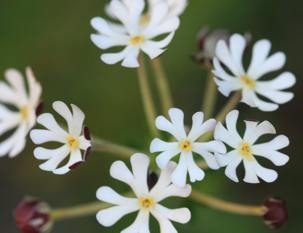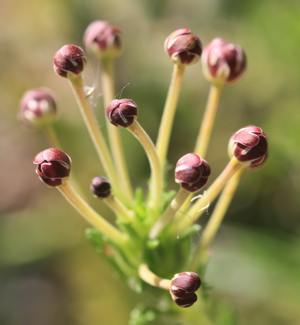Zaluzianskya capensis
Zaluzianskya capensis (L.)Walp.
Family: Marsileaceae
Common names: drumsticks (Eng.); verfblommetjie (Afr.)
Introduction
This plant fills the evening air with a sweet fragrance that will give you joy from May to November. The flowers open towards the evening and remain open until early in the morning. As the light intensity increases they slowly start to close and are completely closed from midday until evening.

Description
Description
Zaluzianskya capensis is an annual that grows up to a height of 500 mm.The leaves are long and narrow, about 40 mm long, sessile (stalkless), toothed, covered with hairs and opposite and/or alternately arranged.

The flowers are grouped at the tip of the stems. The flower buds are deep maroon on the outside when closed, and white and scented when they open towards the evening. The number of petals is five and they are deeply lobed. Each flower has a very noticeable deep yellow centre. The closed flowers resemble drumsticks, hence the designation `drumsticks';. The shape of the flowers also appears to be phlox-like; that is why some people also refer to the species as `night phlox'. The fruit is a capsule.

Conservation Status
Status
This plant enjoys a status of not-threatened, at the moment.
Distribution and habitat
Distribution description
Zaluzianskya capensis is widespread and occurs on sand dunes or lower slopes from Namaqualand to the Eastern Cape.
Derivation of name and historical aspects
History
Zaluzianskya is a genus of flowering plants now regarded as being a member of the Scrophulariaceae, the figwort or snapdragon family. There are 55 species of Zaluzianskya native to southern Africa. They are either annuals or perennial herbs. The annuals seem to be more restricted to the Western Cape, whereas the perennials are more common in the eastern southern Africa.
Zaluzianskya was named in honour of Adam Zaluziansky von Zuluzian, 1558-1613, a physician and botanist from Prague.
Ecology
Ecology
Insects are responsible for the pollination of this plant. The strong scent released by the flowers in the evening suggests that Zaluzianskya capensis is pollinated by moths, such as the night-flying hawk moths of the family Sphingidae. Day-pollinated species of Zaluzianskya often have little or no obvious scent, for example Z. villosa.

Uses
Use
The plant is long-flowering and can be successfully used in the borders of plant beds, and it also complements other lower growing plants when planted amongst them. It makes an ideal pot plant.
Growing Zaluzianskya capensis
Grow
Zaluzianskya capensis looks good when planted in groups and will then make a much greater impact than single plants. The plant needs a good, rich soil that is moist during the summer but well-drained in winter. When watering during the drier periods of the year, make sure that you give it a deep drench, as this will encourage the roots to grow down, and not up looking for water.
Z. capensis is not very hardy but grows well in areas with a mild climate or in warm, sheltered spots; so it is ideal for growing in pots, but ensure that the container drains well. If you need to feed the plant, rather use an organic liquid fertilizer. Z. capensis is attractive when planted among other pots of low-growing perennials such as species of Delosperma of the Mesembryanthemaceae family, or of the Asteraceae family,such as Dimorphotheca jucunda and Gerbera ambigua .
You can propagate the plant with relative ease from cuttings or seed.
Use the following mix for your cuttings:Mix 50% milled pine bark with 50% perlite or coarse river sand. You also have the option to use polystyrene in the place of perlite or river sand. Do note that you may sift the milled bark to get a finer texture. Make the cuttings about 7-8 cm long and dip them in hormone powder number 1 or 2. Plant your cuttings in propagation trays or, alternatively, put your empty plastic ice cream container to good use; it will save you a lot of money! Do make sure that you prick a few holes in the base of the container to ensure good drainage. Roots will start to develop within 2-3 weeks. For the more advanced grower, bench heating will encourage rapid rooting.
When sowing seed, sift a mixture of 50% milled bark and 50% river sand together, compact the mixture lightly in the propagation tray, sow the seeds evenly, and cover with a thin layer of river sand. Water lightly by hand every second day. If seeds are kept under conditions of 15-18° C they will germinate after 4-8 weeks. (E. Hull, senior propagator, Harold Porter National Botanical Garden 2012 pers.comm.).
Aphids can be successfully controlled by spraying with an organic pesticide.
References
- Burman, L. & Bean, A. 1985. Hottentots Holland to Hermanus . South African Wild Flower Guide 5. Botanical Society of South Africa, Kirstenbosch, Claremont.
- Germishuizen, G., Meyer, N.L., Steenkamp, Y. & Keith, M. (eds) 2006. A checklist of South African plants. Southern African Botanical Diversity Network Report No.41. SABONET, Pretoria.
- Goldblatt, P. & Manning, J. 2000. Cape plants. A conspectus of the Cape flora of South Africa. Strelitzia 9. National Botanical Institute, Pretoria & Missouri Botanical
- Garden Press, Missouri.
- Picker, M., Griffiths, C. & Weaving, A. 2002. Field guide to insects of South Africa . Struik, Cape Town.
- Smith, C.A. 1966. Common names of South African plants. Memoirs of the Botanical Survey of South Africa No. 35.
- Trinder-Smith, T.H. 2003. The Levyns guide to the plant genera of the southwestern Cape. Contributions from the Bolus Herbarium 21.
Credits
Benjamin Festus
Harold Porter National Botanical Garden
July 2013
Plant Attributes:
Plant Type: Bi/Annual
SA Distribution: Western Cape
Soil type: Sandy
Flowering season: Spring, Winter
PH: Acid
Flower colour: Purple, White
Aspect: Morning Sun (Semi Shade)
Gardening skill: Easy
Special Features:
Horticultural zones








Rate this article
Article well written and informative
Rate this plant
Is this an interesting plant?
Login to add your Comment
Back to topNot registered yet? Click here to register.